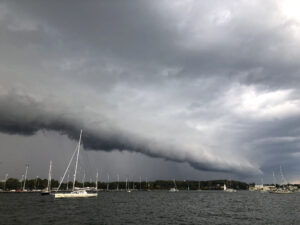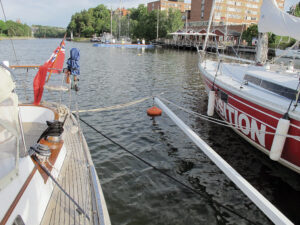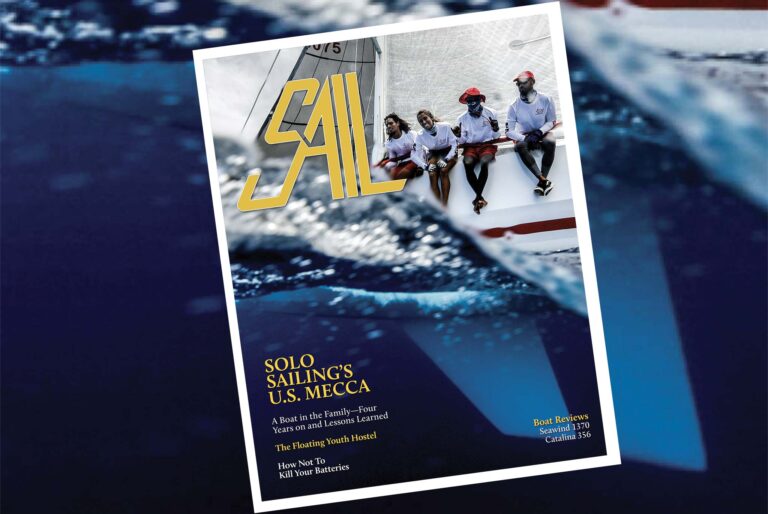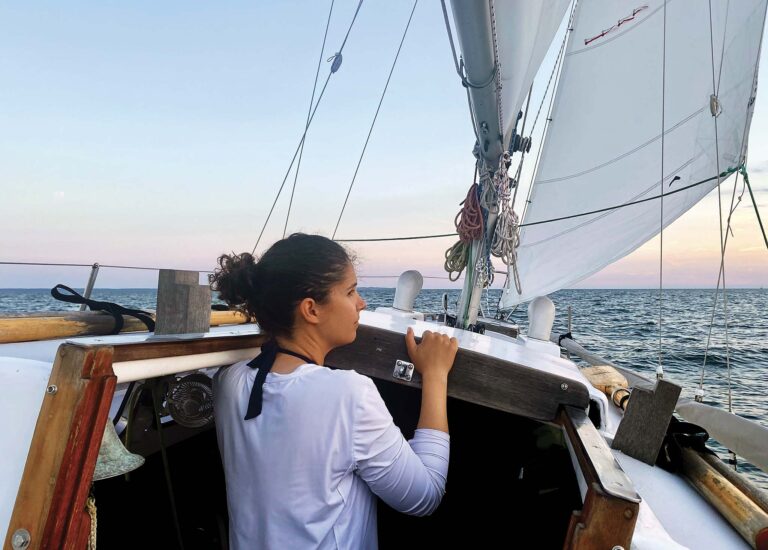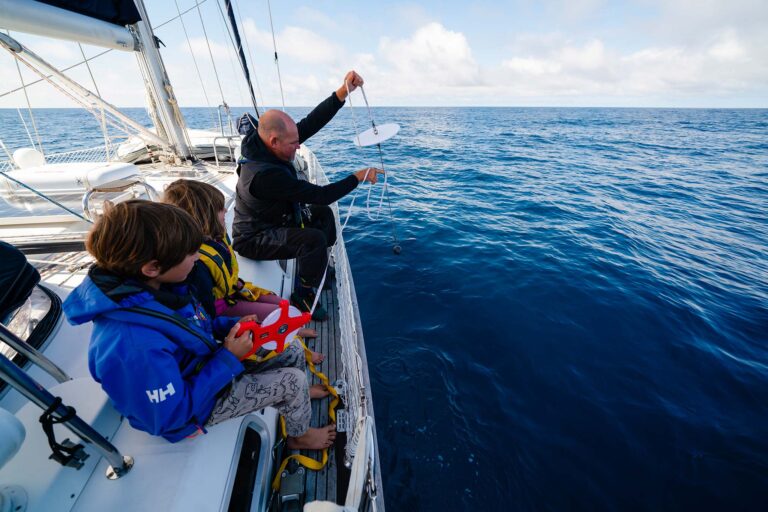During the summer of 2010 my husband, Skip, and I had an opportunity to take a six-week vacation. It was a long-awaited chance for us to cruise to places more distant than those we normally visit during our usual 17 days away. We looked forward to casting off from our homeport in Tacoma, Washington, and making a 1,000-mile round-trip excursion into remote parts of British Columbia aboard Integrity, our Dufour 44. But we were faced with the challenge of bringing along Beth and Sarah, our 16- and 9-year-old daughters, who were reluctant to leave behind their established social lives for what they feared would be a grim wilderness experience.

Due to space limitations and the long duration of our cruise, bringing friends along was not an option. Our daughters staged a rebellion and made our lives a living hell for roughly two weeks prior to setting sail, but we persisted with our vacation plans. With our girls rapidly approaching adulthood, we believed it was now or never if we were to create meaningful cruising memories with them. We did so with success. Here’s what we learned about how to make sailing with teens a pleasurable experience.
Provide Teens With Their Own Space
We took a hard look at how we used the space on our boat and thought about how we could change the way we’d been doing things. We created a space for our teenage daughter, Beth, to call her own, turning a cabin that had been used chiefly for storage into a sleeping area exclusively for her. “You can sleep with your sister, or share a cabin with the kayak, paddles, oars and the dinghy’s sailing kit,” we told her. Not surprisingly, she chose the kayak and gear, and her little sister was glad to no longer be kicked in the night. Even if it means the entire family has to go to bed early so a teen can sleep in the saloon, it is critical to somehow provide the teen with some private space.
Let Teens Have Their Own Stuff
Instead of reacting negatively to all the clutter it would create, we allowed Beth to bring clothes she obviously would have no use for, six pairs of shoes she’d never wear, multiple hair driers, hair straighteners and so forth. We even let her bring her guitar, since she was willing to sleep with it. In other words, we gave her a space to call her own and let her cram it full of whatever she was willing to give up her own living space to accommodate. The rest of us brought less stuff and did give up some of our space to help store her stuff. For example, I gave up some galley storage space to accommodate Beth’s clothes and used less readily accessible space for storing food so she could have certain things handy.
Facilitate Communication with Friends
In this modern age of digital communications your teenager can still maintain an active social life while cruising. To facilitate this, you may need to make adjustments to your cell phone plan. We added a Canadian roaming plan to our cell service that included unlimited texting between the United States and Canada with no per-message charges. We turned off anything for which roaming cell service providers might charge extra: Internet access and photo downloads, for example. Research your plan thoroughly, because there are many features that cost oodles of money if used in remote locations.

One thing we learned is that there were many places where the girls could send and receive text messages even when the cell phone’s signal strength was too weak for voice communication. Encourage your teen to try texting when he or she starts complaining about the phone having a weak signal. Encourage them also to try different spots on the boat; every foot of elevation helps. In a pinch you might even haul them up the mast in a bosun’s chair!
You should also boost your laptop computer’s wireless capability. Even people who live in the “wilderness” do manage to use the Internet as a part of their daily lives. We brought a 4-foot long Wi-Fi antenna (specifically, a 12dBi external omni antenna with 30 feet of solid core copper RF cabling), which we coupled with a Wi-Fi signal amplifier. When needed, we mounted our external antenna on the bow pulpit with a gimbaled clamp. From there we ran the cable through a hatch into the cabin and plugged it into my husband’s laptop. His computer created an onboard Wi-Fi hotspot, so Beth could have wireless Internet access for her laptop.
One bonus to this arrangement was that we could get online with our smartphones for free, even in isolated locations. At some remote marinas in the Broughtons, we used this equipment to open up a wireless network for our neighbors so that everyone could enjoy Internet access without having to wait in line to use a hard-wired connection ashore. With clever passwords suited to each locale, our communal Wi-Fi hot spots made us lots of new friends in secluded places.
We purchased our high-gain Wi-Fi antenna from Broadband Xpress (bbxpress.net) and sometimes used their service where it was available. During our cruise, however, we found that almost every community we visited had at least one free Wi-Fi access point. We were very glad to have our external antenna and signal amplifier so we could access the Internet whenever we moored at a marina or anchored off. [Editor’s note: For tips on installing a permanent mast-mounted Wi-Fi antenna see Don Casey’s “A Moveable Feast” on pg. 60.]
In addition to keeping your teen happy, having good Internet access will make you feel happier, because you’ll be able to escape your teen’s mood swings by logging on yourself. We also found that having Internet access reduced Beth’s cell phone usage, which is harder to regulate. Usually—i.e., unless we were in a fjord—we had a useable signal for one or the other.
You Won’t Be Alone
You will find other children in the places you visit. People do tend to have them. Almost everywhere, you’ll find shopkeepers, marina staff and other folk with offspring still residing with them. There will also be other cruisers traveling with their children or grandchildren. Rest assured, you are not the only parents who occasionally force a teen to come along on a family vacation. The marinas we visited were always cooperative about helping children find other children. While not every place we visited had other teenagers, there were always boaters traveling with pets for our children to befriend. Indeed, with our shy teen, we found it was more difficult to get her to leave the boat if there were other teenagers around. On the other hand, Sarah, our 9-year-old, was eager to meet anyone and everyone under the age of 12.

Unplug Occasionally
Though it is essential to allow your teen to communicate with friends, don’t cave into every demand for a marina berth and a shore-power connection. We had our best times when we were anchored out and the kids amused themselves swinging from a halyard and jumping into the water. When we lacked both cell service and Internet access, the girls actually did things together.
In hindsight, if we were to do this trip again, we would spend more time anchored in isolated locations. The few times we lacked cell service and Internet access were the only times we played family board games, like we did on the boat when the children were younger. Your teen may complain in advance of the anchor being dropped, but will relent (and even manage to have a good time) after seeing it is non-negotiable.
Bribe as Necessary
Some use the term “reward,” but I found it necessary to elicit my teen’s cooperation with what is more aptly called bribery. Some examples: “If you come along willingly, are packed and ready to go on time, and put a happy face on for this trip, I’ll take you clothes-shopping when we get to Sidney.” (We figured our teen wouldn’t actually follow through on a threat to run away from home once we got her across the border into Canada.) “If you’ll be more pleasant, we’ll go out to dinner in Port Hardy.” Other effective bribes included a promise to stop somewhere with a swimming pool and a trip to a nail salon.
While cruising with a teen is definitely not for everyone, it is possible to do it, even with a teenager who is opposed to the cruise. Our trip proved to be relatively successful because of the effort we made to keep our boat teen-friendly. Despite all the pre-departure angst and drama, we not only survived the experience but actually had a good time. The trip got better and better with each passing mile, and I am confident one day my children will tell their children about their fond memories of that one last summer cruise we took together as a family.


